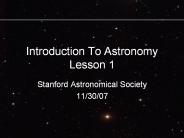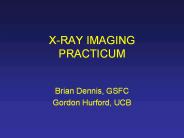Arcminute PowerPoint PPT Presentations
All Time
Recommended
Joint Analysis of Weak Lensing and SZE data from the Arcminute Microkelvin Imager
| PowerPoint PPT presentation | free to download
70 Jy in 1 hour. 12-18 GHz in 8 sub-bands. Excellent low-surface brightness sensitivity ... Sited on Observatorio del Teide, Tenerife ...
| PowerPoint PPT presentation | free to view
Getting the Distances to Stars: Stellar Parallax ... P, the parallax angle, is measured in arcseconds. 60 arcseconds = 1 arcminute ... Use parallax. ...
| PowerPoint PPT presentation | free to download
the only way for astronomers to investigate the universe. Properties ... Angles are being measured in degrees, arcminutes (degree/60) and arcseconds (arcmin/60) ...
| PowerPoint PPT presentation | free to view
Astronomy 143: Wednesday, September 24. Professor Barbara Ryden. The History ... 110: History of Life on Earth Anthropology 200: Intro to Physical Anthropology ...
| PowerPoint PPT presentation | free to download
Title: PowerPoint Presentation Author: Julie A. Rathbun Last modified by: Julie A. Rathbun Created Date: 8/14/2001 6:19:29 PM Document presentation format
| PowerPoint PPT presentation | free to download
Study of the temperature dependence of the GaN buffer layer on SiC. ... used for buffer layer deposition on sapphire, reference (a) 9000 C. 9500 C. 9700 C (~temp. ...
| PowerPoint PPT presentation | free to download
A Primer on SZ Surveys. Gil Holder. Institute for Advanced Study. Outline ... Central decrement vs Mass 40% scatter. Average SZ flux vs Mass 10% scatter ...
| PowerPoint PPT presentation | free to download
Astronomy 101 The Solar System Tuesday, Thursday 2:30-3:45 pm Hasbrouck 20 Tom Burbine tomburbine@astro.umass.edu
| PowerPoint PPT presentation | free to download
Astronomy 100 Tuesday, Thursday 2:30 - 3:45 pm Tom Burbine tburbine@mtholyoke.edu
| PowerPoint PPT presentation | free to download
Magnification. The magnification is determined by the focal lengths of the telescope and ... More magnification makes image dimmer. Light spread over a larger area ...
| PowerPoint PPT presentation | free to download
Measuring the Distance to Stars The Parallax Method To the naked eye stars are so far away that they do not appear to change positions even though we are rotating ...
| PowerPoint PPT presentation | free to view
Grid Fabrication. and. Characterization. Brian Dennis, GSFC. Gordon Hurford, UCB ... Grid #4 transmission as a function of angle to normal & energy. ...
| PowerPoint PPT presentation | free to download
Discovering
- CHAPTER 1: Discovering the Night Sky Constellations,Asterisms and the Celestial Sphere
CHAPTER 1: Discovering the Night Sky Constellations,Asterisms and the Celestial Sphere
| PowerPoint PPT presentation | free to download
Most Basic Method of Stellar Distance Determination ... situation for nearby stars to get an idea of the immensity of interstellar space ...
| PowerPoint PPT presentation | free to view
Title: ASTR 1120 General Astronomy: Stars and Galaxies Author: Webster Cash Last modified by: Josh Moloney Created Date: 1/7/2003 8:43:45 PM Document presentation format
| PowerPoint PPT presentation | free to download
Title: Participation of HEND in the Program of Interplanetary Network of localization of cosmic gamma-ray bursts Author: dima Last modified by
| PowerPoint PPT presentation | free to download
Zerodur VLT primary at REOSC * More materials Silicon Carbide Low ... Pyramid WFS Fast steering mirror is needed to get all pixels in focus * Sensor ...
| PowerPoint PPT presentation | free to download
Title: PowerPoint Presentation Author: Eddie Guerra Last modified by: Astronomical Observatory Created Date: 5/29/2001 3:11:59 AM Document presentation format
| PowerPoint PPT presentation | free to download
Geocentric (ITRF96/GRS-80) New for G99SSS (vs. G96SSS) KMS98 altimetry ... Non-geocentric: NAD 83 -- NAVD 88. PICTURE OF 6169 GPSBMS. PICTURE OF GEOID99 ...
| PowerPoint PPT presentation | free to view
Astronomy 100 The Solar System Tuesday, Wednesday, Thursday Tom Burbine tomburbine@astro.umass.edu
| PowerPoint PPT presentation | free to download
Title: Kein Folientitel Author: IS Last modified by: Systems Administrators Created Date: 5/8/2005 5:46:07 PM Document presentation format: On-screen Show
| PowerPoint PPT presentation | free to download
The Constellations Northern constellations named for figures in Greek myth Attempt to understand heavens Astronomical Landmarks The Constellation Orion Q: ...
| PowerPoint PPT presentation | free to view
Annapolis, MD July 28-30. Collaborators. Experiment Details. K s1/2. Instrument NEQ ... Please describe the following items, as well as anything else we need to ...
| PowerPoint PPT presentation | free to download
And now tonight s lab We ll be measuring field of view of our telescope (angular size seen through the telescope) Primary Method ...
| PowerPoint PPT presentation | free to download
Somnath Bharadwaj and Pratik Khastgir, Department of Physics ... Chromatic Resolving Power. PHYSICS 1 ... Chromatic Resolving Power. ninina. maxima. PHYSICS 1 ...
| PowerPoint PPT presentation | free to view
How long does one cycle take? Precession The Earth has a bulge. The Moon
| PowerPoint PPT presentation | free to view
Star Tracker 5000 A low-cost star tracker and attitude determination system Tracking ST5000 tracks at 10 Hz 3-axis tracking, Yaw, Pitch & Roll In-flight performance ...
| PowerPoint PPT presentation | free to download
Optics in Astronomy - Interferometry - Oskar von der L he Kiepenheuer-Institut f r Sonnenphysik Freiburg, Germany
| PowerPoint PPT presentation | free to view
Title: Chandra Image of Sagittarius A* Field Author: Valued Sony Customer Last modified by: Valued Sony Customer Created Date: 1/3/2003 2:01:25 AM
| PowerPoint PPT presentation | free to download
Astronomy 101 The Solar System Tuesday, Thursday Tom Burbine tomburbine@astro.umass.edu
| PowerPoint PPT presentation | free to download
single dishes with bolometer camers. SPT, APEX, ACT, etc. or small interferometers ... fast bolometer array or interferometer. e.g. SPT,APEX,SZA,AMI. 23 ...
| PowerPoint PPT presentation | free to download
Introduction To Astronomy Lesson 1 Stanford Astronomical Society 11/30/07 Topics for this Lesson Earth Based Coordinates The Celestial Sphere and Sky Coordinates The ...
| PowerPoint PPT presentation | free to download
OTF(r) = e-Dapl(r)/2 OTFgs(r) Turbulence profile. Cn2(z) Zenith angle. z. Obs. wavelength. l. Aperture diameter. D. G.S. angular offset. q. Dapl(r) depends on ...
| PowerPoint PPT presentation | free to view
Low Hanging Fruit in The New Radio Sky or Radio Surveys and Transients with the Allen Telescope Arra
| PowerPoint PPT presentation | free to download
Science Drivers Brown dwarfs. Slit Mask. Detector (Image from Flamingos) Multi-Slit Spectrograph. Basic Operational Modes. Imaging ...
| PowerPoint PPT presentation | free to download
leveraging LSST Tony Tyson Director, LSST Project University of California, Davis *
| PowerPoint PPT presentation | free to download
Therefore, a solar eclipse must always occur around the time of New Moon ... If it has to be a New Moon for a solar eclipse, why doesn't one happen every month? ...
| PowerPoint PPT presentation | free to download
Characteristic size from peak of matter power ... deflection angle on sky given in terms of lensing potential ... BUT: depends on CMB gradient behind a ...
| PowerPoint PPT presentation | free to download
The Copernican Revolution The Beginning of Modern Astronomy The 15th Century In 1453 Ottoman Turks overrun Constantinople. Romans flee west into Europe and take books ...
| PowerPoint PPT presentation | free to download
Math Reminder Reference Fran Bagenal http://lasp.colorado.edu/~bagenal/MATH/main.html Contents 0 General Problem Solving Tips 1 Scientific Notation 2 Units - how to ...
| PowerPoint PPT presentation | free to download
Black Holes: Observations Lecture 2: BHs in close binaries Sergei Popov (SAI MSU) Plan of the lecture Reviews X-ray observations: Cyg X-1 X-ray novae X-ray nova light ...
| PowerPoint PPT presentation | free to download
Universe Eighth Edition CHAPTER 1 Astronomy and the Universe By reading this chapter, you will learn 1-1 What distinguishes the methods of science from other human ...
| PowerPoint PPT presentation | free to view
... to observe sky (1610). Mountains on the moon. Rings of Saturn. Sunspots. Milky Way is made of stars. Observations of Venus. Venus has phases similar to the moon. ...
| PowerPoint PPT presentation | free to view
astronomy look up. look way, way up. what do you see? sun, moon, stars
| PowerPoint PPT presentation | free to view
High Resolution. X-ray Spectroscopic Constraints. on Cooling-Flow Models. John Peterson, ... RGS (dispersive spectrometer) : High dispersion angles (3 degrees) ...
| PowerPoint PPT presentation | free to view
You now know the angular size of this galaxy and can assume its actual diameter. Use the small angle formula to determine the distance to the galaxy in LY. ...
| PowerPoint PPT presentation | free to view
... SSDIF I+T trade, Ariane assessment and will recommend a reduction to the sensitivity and stray light relaxation commensurate with that needed.
| PowerPoint PPT presentation | free to download
Optics Basics. All telescopes are based upon two basics properties of optics ... by the Energetic Gamma-Ray Experiment Telescope (EGRET) instrument on the ...
| PowerPoint PPT presentation | free to view
Definitions: parallax (p), Astronomical Unit [AU], parsec [pc] ... Astronomical Distance Ladder. Special Theory of Relativity (STR) ...
| PowerPoint PPT presentation | free to download
X-RAY IMAGING PRACTICUM. Brian Dennis, GSFC. Gordon Hurford, UCB. X-RAY IMAGING PRACTICUM. Objectives. Intuitive perspective on RMC imaging ...
| PowerPoint PPT presentation | free to download
... Plane Survey. Image Courtesy: Cormac Purcell. Andrew Walsh (JCU) ... Kate Brooks (ATNF) Chris Phillips (ATNF) Shari Breen (UTas) Maria Cunningham (UNSW) ...
| PowerPoint PPT presentation | free to download
Lecture 6 Galileo and Brahe
| PowerPoint PPT presentation | free to view
Line: H2 (2.4 m), PAHs (3.3 m), Bra (4.05 m) Continuum: L (3.5 m), M (4.8 m) ... Star Formation and the Galactic Ecology. PDRs to HII regions: ...
| PowerPoint PPT presentation | free to download
... look at van der Laan's paper shows that the Cen A data do not match the picture ... Light curve shows X-ray brightness varying with time. ...
| PowerPoint PPT presentation | free to download
























































